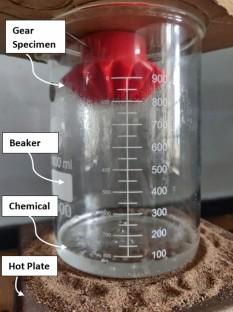Polymer Bulletin ( IF 3.1 ) Pub Date : 2023-07-18 , DOI: 10.1007/s00289-023-04900-8 Nagarjun Jayakumar , Hariharan Arumugam , Anto Dilip Albert Selvaraj

|
FDM, being the most popular AM technology, has a wide user base across the globe. The process makes use of a layer-by-layer approach, causing a staircase effect on the material’s printed surface. Though it affects several mechanical properties, its effect on surface integrity is highly detrimental and needs to be addressed. Chemical vapour dip and immersion techniques can provide a rapid solution using solvents. The solvents employed in the current study were the polar solvents- acetone and ethyl acetate, the mid-polar solvent- tetrahydrofuran (THF), and the non-polar solvents- chloroform and dichloromethane (DCM). The superior surface finish obtained during the post processing of 3D printed parts was having mean roughness value (Ra) of 0.67 µm, originally 11.42 µm. It was obtained when experimentation was carried out with the chemical vapour technique using THF. The optimum surface finish was readily achieved with mid- and non-polar solvents, whereas the polar solvents were slow to react with the surface of the PLA. A number of variables, including the solvent's polarity, boiling point, vapour pressure, and water miscibility, have an impact on the final surface's appearance and strength. During vapour treatment, the tensile strength of the 3D printed parts got reduced between 11.6% (THF) to 43.78% (DCM). On the other hand, the chemical immersion technique has a even more impact on the material’s strength and hardness. It reduces hardness to the maximum of 44.41% (THF), whereas the vapour evaporation technique reduces hardness by only up to 14.64% (chloroform).
中文翻译:

使用极性和非极性溶剂进行后处理的 3D 打印 PLA 零件的机械行为
FDM 是最流行的 AM 技术,在全球拥有广泛的用户群。该过程采用逐层方法,在材料的印刷表面上产生阶梯效果。尽管它会影响多种机械性能,但它对表面完整性的影响非常有害,需要解决。化学气相浸渍和浸泡技术可以使用溶剂提供快速解决方案。本研究中使用的溶剂是极性溶剂-丙酮和乙酸乙酯,中极性溶剂-四氢呋喃(THF),以及非极性溶剂-氯仿和二氯甲烷(DCM)。3D 打印部件后处理过程中获得的优异表面光洁度的平均粗糙度值 (R a ) 为 0.67 µm,最初为 11.42 µm。它是通过使用 THF 的化学气相技术进行实验时获得的。使用中极性和非极性溶剂可以轻松实现最佳表面光洁度,而极性溶剂与 PLA 表面反应缓慢。许多变量,包括溶剂的极性、沸点、蒸气压和水混溶性,都会对最终表面的外观和强度产生影响。在蒸汽处理过程中,3D 打印部件的拉伸强度降低了 11.6% (THF) 至 43.78% (DCM)。另一方面,化学浸泡技术对材料的强度和硬度影响更大。它将硬度最大降低至 44.41% (THF),而蒸汽蒸发技术最多仅将硬度降低 14.64%(氯仿)。
















































 京公网安备 11010802027423号
京公网安备 11010802027423号